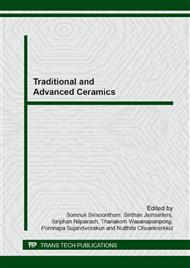p.212
p.218
p.224
p.230
p.235
p.241
p.247
p.253
p.259
Fabrication of Silicon Carbide from Rice Husk by Carbothermal-Reduction and In Situ Reaction Bonding Technique
Abstract:
Silicon carbide (SiC) ceramics were prepared by carbothermal reduction together with in-situ reaction bonding. Raw rice husk was carbonized in an incineration furnace. The carbonized rice husk was ground and was then treated with hydrochloric acid by varying concentrations. The sample powders were mixed with silicon metal powder and pyrolyzed at various temperatures in either argon or nitrogen atmosphere. Silicon carbide phase was found in all pyrolyzed samples. Cristobalite was found in argon atmosphere pyrolyzed samples while silicon oxynitride was found in the samples pyrolyzed in nitrogen atmosphere at lower than 1500 °C. Silicon carbide whisker is the main phase on the surface of pyrolyzed sample. Increasing pyrolysis temperatures decreased the amount and size of silicon carbide whisker but increased the silicon carbide particle. Porosity and weight loss of samples after pyrolysis were increased with increasing temperatures due to the reaction in the system.
Info:
Periodical:
Pages:
235-240
Citation:
Online since:
April 2014
Keywords:
Price:
Сopyright:
© 2014 Trans Tech Publications Ltd. All Rights Reserved
Share:
Citation:


